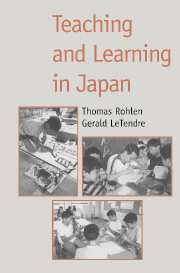Book contents
- Frontmatter
- Contents
- List of contributors
- Introduction: Japanese theories of learning
- Section I Fundamental approaches
- Section II The emotional foundations of early learning
- Section III School and classroom models
- Section IV Path and guidance
- Section V Artistic pursuits – old and new
- Conclusion: themes in the Japanese culture of learning
- References
- Index
Section V - Artistic pursuits – old and new
Published online by Cambridge University Press: 05 June 2012
- Frontmatter
- Contents
- List of contributors
- Introduction: Japanese theories of learning
- Section I Fundamental approaches
- Section II The emotional foundations of early learning
- Section III School and classroom models
- Section IV Path and guidance
- Section V Artistic pursuits – old and new
- Conclusion: themes in the Japanese culture of learning
- References
- Index
Summary
Visitors expect Japan to be filled with evidence of the country's aesthetic sensibilities, but today, short of sightseeing at ancient gardens and temples, most are disappointed. One has to look deep into the recesses of private lives to discover the vibrancy of Japan's famed engagement with the arts, but it certainly exists. Children study music at school as a matter of course. A surprisingly large number also learn an instrument from a private teacher from an early age. On virtually every college campus, one finds student clubs centering on such pursuits as the tea ceremony, ballroom dancing, drama, and flower arranging. The same is true of companies, where similar kinds of clubs are popular. The range of courses in public recreation centers is also impressive, as is the wealth of offerings of private “schools” specializing in a particular traditional art. Cooking classes abound, as do classes in painting and various crafts.
What all this adds up to is a society seemingly saturated with the study of artistic expression. Recall that Japan is home to the Yamaha assemblage of innovative musical instruments, to the Suzuki Method, to some of the world's top classical and jazz musicians, and to schools of tea and flower arranging with millions of dues-paying members. By labeling the subject of all this learning as “art” and “expression,” we have imposed a Western idea on a Japanese phenomenon that is actually wider, more inclusive, and different in its basic intent.
- Type
- Chapter
- Information
- Teaching and Learning in Japan , pp. 321 - 322Publisher: Cambridge University PressPrint publication year: 1996



